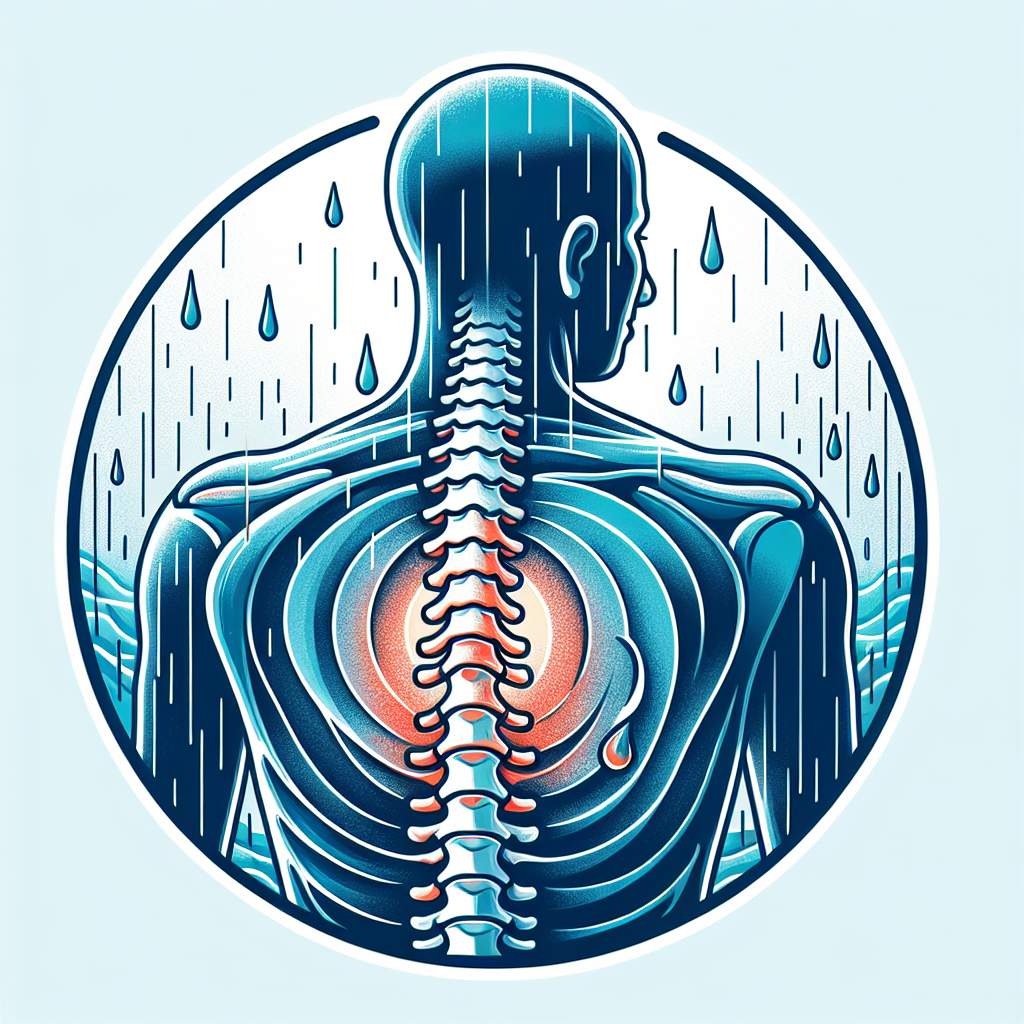
How Do Weather Changes Affect Lower Back Pain and the Lumbar Region?
Have you ever noticed that your lower back pain seems to get worse when the weather changes? Well, you’re not alone. Many people experience a correlation between weather changes and increased discomfort in their lumbar region. This phenomenon has long intrigued scientists and medical professionals, prompting them to explore the connection between the two. In this article, we’ll take a closer look at how weather changes affect lower back pain and their impact on the delicate lumbar region. So grab a cup of coffee, sit back, and let’s unravel the mysteries behind this intriguing relationship.
The Link Between Weather Changes and Lower Back Pain
Have you ever noticed that your lower back pain seems to flare up when the weather changes? If so, you’re not alone. Many people experience a correlation between weather patterns and their level of pain or discomfort in the lumbar region. While it may seem like an unusual connection, there is scientific evidence to support this phenomenon. In this article, we will explore how weather changes can affect the lumbar region, focusing on three key factors: barometric pressure, temperature, and humidity levels.
How Does Weather Affect the Lumbar Region?
The lumbar region, which consists of the lower portion of the spine, is particularly susceptible to changes in weather conditions. This is due to the complex network of nerves, muscles, and ligaments that make up the lower back. When these structures are exposed to certain weather conditions, such as changes in barometric pressure, temperature, or humidity, they can become more prone to inflammation and irritation, leading to lower back pain.

How Do Weather Changes Affect Lower Back Pain and the Lumbar Region?
The Role of Barometric Pressure
Barometric pressure, also known as atmospheric pressure, refers to the weight of the air in the atmosphere. When the barometric pressure changes, it can have a direct impact on your body, particularly in the lumbar region. Studies have shown that when there is a decrease in barometric pressure, such as before a storm, it can cause the tissues and fluids in the body to expand. This expansion can lead to increased pressure on the nerves in the lower back, resulting in pain and discomfort.
The Impact of Temperature Changes
Temperature fluctuations can also have a significant effect on the lumbar region. Cold temperatures, in particular, can cause the muscles and ligaments in the lower back to contract, leading to stiffness and discomfort. On the other hand, hot weather can cause the tissues to become more relaxed, potentially exacerbating existing pain or inflammation in the area.

How Do Weather Changes Affect Lower Back Pain and the Lumbar Region?
The Influence of Humidity Levels
Humidity, which refers to the amount of moisture in the air, can also play a role in lower back pain. High humidity levels can cause the body to retain more water, leading to increased fluid buildup in the tissues. This excess fluid can put pressure on the nerves in the lumbar region, resulting in pain and stiffness. Conversely, low humidity levels can cause the tissues to dry out, making them more susceptible to injury and irritation.
Seasonal Variations in Lower Back Pain
Now that we understand how weather changes can affect the lumbar region, let’s explore how these effects may vary throughout the different seasons.
Winter
Winter can be a challenging time for individuals with lower back pain. The cold temperatures can cause the muscles and ligaments to tighten, leading to increased stiffness and discomfort. Additionally, the lack of sunlight during the winter months can contribute to feelings of depression and fatigue, which can further impact one’s perception of pain.
Spring
Spring brings a sense of renewal and hope, but it can also bring its own set of challenges for those with lower back pain. As the weather begins to warm up, the muscles and ligaments in the lumbar region may experience increased relaxation. While this may initially seem like a positive change, it can actually lead to instability and a heightened risk of injury.
Summer
The hot and humid weather of summer can be particularly difficult for individuals with lower back pain. The combination of high temperatures and increased humidity levels can lead to excessive sweating, which can dehydrate the body and cause the tissues to become more inflamed. Additionally, outdoor activities and vacations during the summer months can increase the risk of injury or strain on the lower back.
Fall
Fall is often considered a transitional season, with fluctuations in temperature and weather patterns. For individuals with lower back pain, this can mean a mix of relief and discomfort. As the weather cools down, the muscles and ligaments in the lumbar region may experience increased stiffness. However, the lower humidity levels can help reduce fluid retention and alleviate some of the pressure on the nerves.

How Do Weather Changes Affect Lower Back Pain and the Lumbar Region?
Specific Weather Conditions and Their Effects
While we have discussed the overall impact of weather changes on lower back pain, it’s important to delve deeper into specific weather conditions and their effects on the lumbar region.
Rain
Rainy weather can worsen lower back pain for several reasons. The drop in barometric pressure that often accompanies rain can cause tissues and fluids to expand, increasing pressure on the nerves in the lower back. Additionally, the dampness and moisture in the air can lead to increased muscle stiffness and discomfort.
Cold Weather
Cold temperatures can cause the muscles and ligaments in the lower back to contract, leading to increased stiffness and pain. Cold weather can also constrict blood vessels, reducing the flow of oxygen and nutrients to the tissues in the lumbar region. This lack of oxygen and nutrients can further exacerbate existing pain or inflammation.
Hot Weather
Hot weather can be both a blessing and a curse for individuals with lower back pain. While heat can help relax the muscles and provide temporary relief, excessive heat can also lead to dehydration and increased sweating. This can lead to fluid retention and inflammation in the lower back, resulting in heightened pain and discomfort.
Humidity
High humidity levels can cause the body to retain more water, leading to increased fluid buildup in the tissues of the lumbar region. This additional fluid can put pressure on the nerves and result in pain and stiffness. Conversely, low humidity levels can cause the tissues to dry out and become more susceptible to injury and irritation.
Barometric Pressure and Lower Back Pain
Of all the weather factors, barometric pressure has been closely studied in relation to lower back pain. Let’s explore the connection between barometric pressure and pain, as well as the effects of decreased and increased atmospheric pressure on the lumbar region.
The Connection between Barometric Pressure and Pain
Research has shown a clear link between changes in barometric pressure and an increase in pain sensitivity. When the barometric pressure drops, such as before a storm, it can cause the tissues and fluids in the body to expand. This expansion can put pressure on the nerves in the lumbar region, leading to heightened pain and discomfort.
Decreased Atmospheric Pressure
A decrease in atmospheric pressure, often associated with stormy weather, can have a significant impact on individuals with lower back pain. The expansion of tissues and fluids can increase the pressure on the nerves, resulting in heightened pain and discomfort. Additionally, the decrease in oxygen levels at higher altitudes, which often accompany low atmospheric pressure, can further exacerbate pain and inflammation in the lumbar region.
Increased Atmospheric Pressure
While a decrease in atmospheric pressure can worsen lower back pain, an increase in atmospheric pressure may provide some relief for individuals with this condition. However, it’s important to note that the effects may vary from person to person. Some individuals may experience a decrease in pain and discomfort when the pressure rises, while others may not notice any significant changes.
Joint Fluid Pressure
Barometric pressure can also affect the fluid pressure within the joints of the spine. When there are fluctuations in atmospheric pressure, it can lead to changes in the pressure of the fluid in the joints of the lumbar region. This can result in increased pain and discomfort, especially for individuals with conditions such as osteoarthritis or degenerative disc disease.

Temperature and Lower Back Pain
In addition to barometric pressure, temperature can also have a significant impact on lower back pain. Let’s explore how cold and hot temperatures can affect the lumbar region.
The Influence of Cold Temperature
Cold temperatures can cause the muscles and ligaments in the lower back to contract, leading to increased stiffness and discomfort. This is particularly noticeable when transitioning from a warm environment to a cold one, such as going outside on a winter day. The sudden change in temperature can result in muscle spasms and increased pain.
The Impact of Heat on Lower Back Pain
Heat can have both positive and negative effects on lower back pain. Applying heat to the lumbar region can help relax the muscles and increase blood flow, providing temporary relief from pain and stiffness. Heat therapy, such as using a heating pad or taking a warm bath, can be particularly beneficial for individuals with muscle strains or spasms in the lower back. However, it’s important to avoid excessive heat, which can lead to burns or further inflammation.
Humidity Levels and Their Effect on Lower Back Pain
Humidity, which refers to the amount of moisture in the air, can also play a role in lower back pain. Let’s explore the relationship between humidity and pain, as well as the effects of hot and cold humid conditions on the lumbar region.
The Relationship between Humidity and Pain
High humidity levels can cause the body to retain more water, leading to increased fluid buildup in the tissues surrounding the nerves in the lumbar region. This excess fluid can put pressure on the nerves, resulting in pain and stiffness. Conversely, low humidity levels can cause the tissues to dry out, making them more susceptible to injury and irritation.
Hot and Humid Conditions
Hot and humid conditions can be particularly challenging for individuals with lower back pain. The combination of high temperatures and increased humidity levels can lead to excessive sweating and dehydration. This can cause the tissues to become more inflamed and further exacerbate existing pain or discomfort in the lumbar region.
Cold and Humid Conditions
Cold and humid conditions can also have an impact on lower back pain. The moisture in the air can cause the tissues to become damp and increase the risk of muscle stiffness and discomfort. Additionally, cold temperatures can further exacerbate pain by causing the muscles and ligaments to contract.

How to Manage Lower Back Pain during Weather Changes
Now that we understand the link between weather changes and lower back pain, it’s important to explore strategies for managing and reducing pain during these fluctuations. Here are some tips to help you navigate weather-related discomfort in the lumbar region.
Stay Active and Exercise Regularly
Engaging in regular physical activity can help strengthen the muscles in the lower back and improve flexibility. Exercises that focus on core strength and stability, such as Pilates or yoga, can be particularly beneficial for individuals with lower back pain. Additionally, staying active can help increase blood flow to the lumbar region, reducing inflammation and promoting healing.
Maintain Good Posture
Maintaining proper posture throughout the day can help alleviate strain on the lower back. Make sure to sit and stand with your spine aligned, avoiding slouching or hunching forward. Using ergonomic furniture and supportive cushions can also help promote good posture and reduce the risk of lower back pain.
Apply Heat or Cold Therapy
Applying heat or cold therapy to the lumbar region can help alleviate pain and reduce inflammation. For acute pain or muscle spasms, applying a cold pack or ice wrapped in a towel can provide relief. For chronic pain or stiffness, using a heating pad or taking a warm bath can help relax the muscles and increase blood flow.
Consider Alternative Treatments
Alternative treatments, such as acupuncture or chiropractic adjustments, may help alleviate lower back pain during weather changes. These therapies focus on targeting specific pressure points or realigning the spine to reduce tension and promote healing. It’s important to consult with a qualified healthcare professional before trying any alternative treatments to ensure their safety and efficacy.
Consult a Healthcare Provider
If your lower back pain persists or worsens during weather changes, it’s essential to consult with a healthcare provider. They can assess your condition, provide a proper diagnosis, and recommend appropriate treatment options. They may also suggest additional strategies for managing pain during weather fluctuations, such as topical creams or oral medications.
Conclusion
Weather changes can have a profound impact on lower back pain and the lumbar region. Factors such as barometric pressure, temperature, and humidity levels can contribute to increased pain, stiffness, and discomfort. Understanding the link between weather conditions and lower back pain can help you better manage your symptoms and take proactive steps to reduce pain during these fluctuations. By staying active, maintaining good posture, applying heat or cold therapy, considering alternative treatments, and consulting with a healthcare provider, you can effectively manage lower back pain and improve your overall well-being, regardless of the weather.









